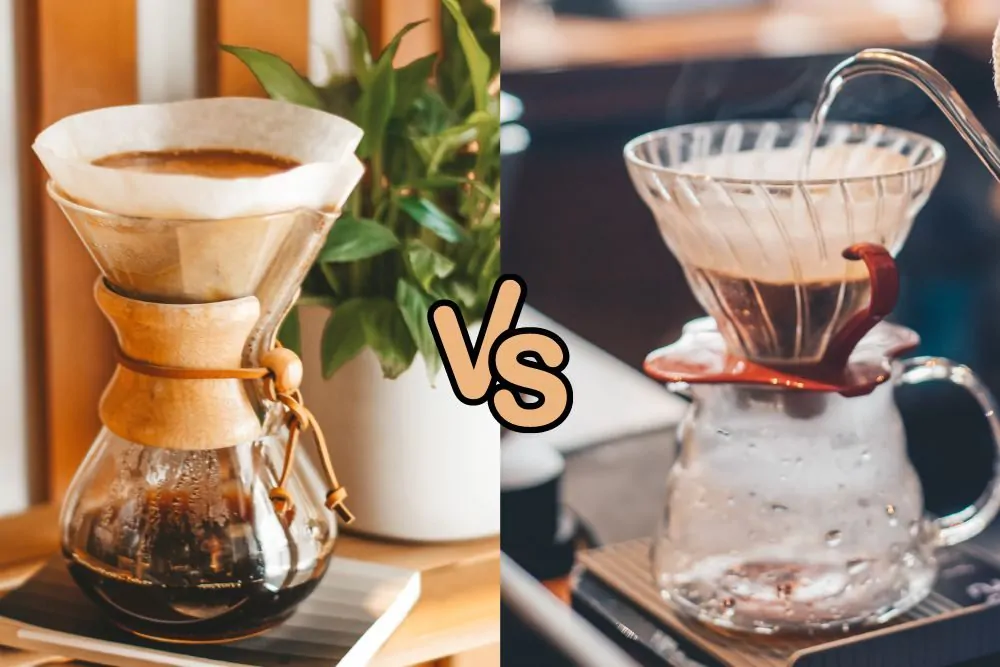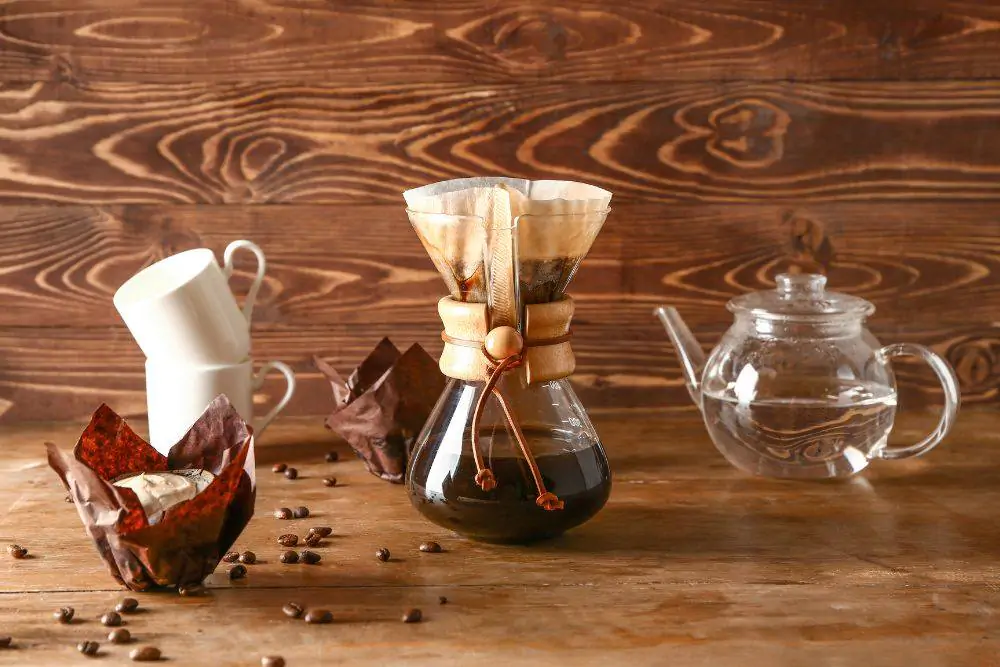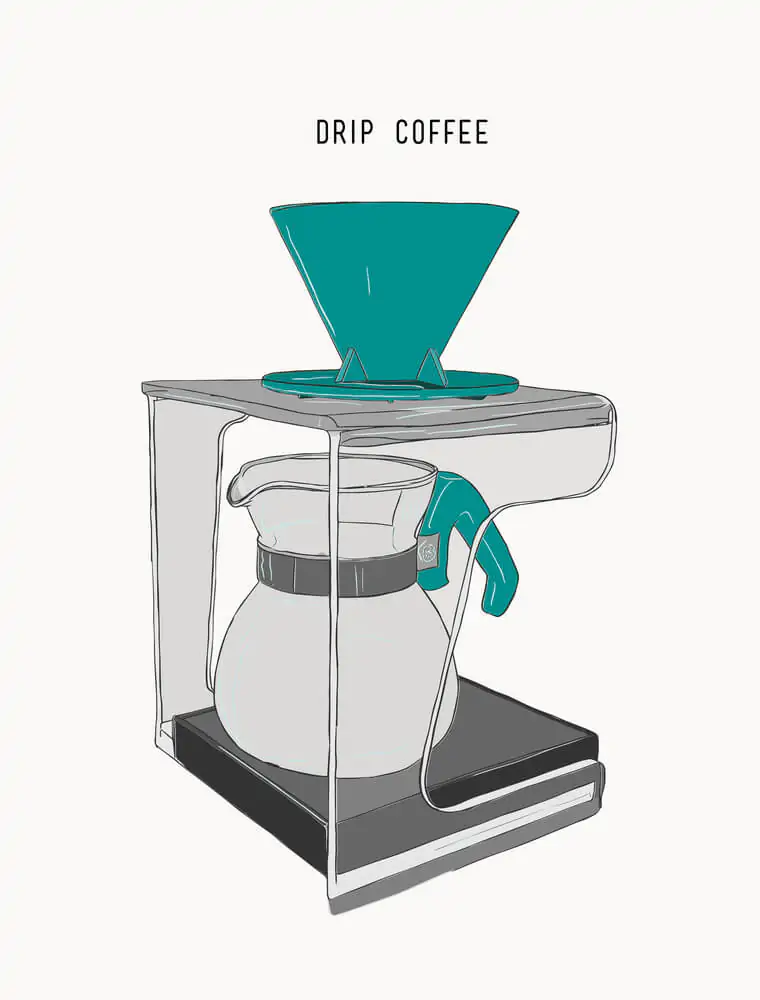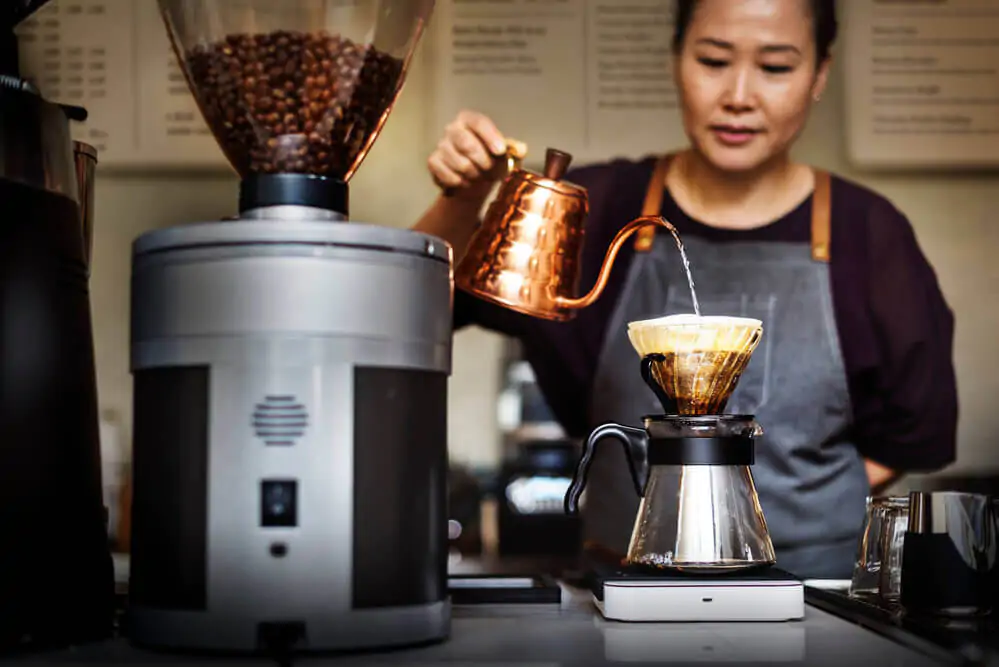In the great Chemex Vs. Drip coffee maker debate, which one will come out on top? The answer depends on what you want from your perfect cup of coffee.

I’m a big fan of my drip coffee maker, but some of my friends have been telling me to get a Chemex. They say that the flavor is better, the coffee is fresher, and the cook has more control over the brewing process. Of course, I’m not one to buy a product without researching it first. So, how do you compare a Chemex to a drip coffee maker?
The Chemex brewing method uses a manual pour-over technique involving a thicker filter paper and allows for more control over variables like water temperature and brew time, resulting in a cleaner and brighter-tasting coffee. On the other hand, a drip coffee maker automates the brewing process, typically using thinner filters and resulting in a fuller-bodied, more robust coffee. Expect less control over brewing parameters.
Using the best Chemex requires more skill but produces better-tasting coffee. Drip coffee makers are a good choice for a simple, fast cup of joe.
- What is A Chemex?
- What Is A Drip Coffee Maker?
- Comparing A Chemex To A Normal Drip Coffee Maker
- Chemex: High-End Pour-Over Coffee
- Why Pour-Over Coffee Has More Caffeine
- The Pros And Cons Of Drip Coffee Makers
- Mimicking The Chemex Flavor With A Drip Coffee Maker
- Who Should Get a Chemex and Why?
- Who Should Get an Auto Drip and Why?
- Chemex Vs. Drip Coffee Maker: Related Questions
- Chemex Comparisons
What is A Chemex?
Chemex is a manual pour-over-style glass coffeemaker. It consists of an hourglass-shaped flask with a conical funnel-like neck and special filters that are made of bonded paper, which are much thicker than the filters used in a conventional drip coffeemaker.
The Chemex was invented in 1941 by German chemist Peter J. Schlumbohm. The air of the chemist’s lab is quite obvious in the composition and shape of the coffeemaker. Dr. Schlumbohm invented the Chemex by fusing a glass funnel and an Erlenmeyer flask.

What Is A Drip Coffee Maker?
An automatic drip coffee maker is a brewing device that uses the filter-drip method to make coffee. The brewing process involves water being heated in a reservoir before it drips through a basket of ground coffee, typically contained in a disposable or reusable filter. The hot water extracts flavors and compounds from the grounds, and the resulting brewed coffee then drips into a carafe or pot below.

This dripping of the coffee into the pot produces an aroma well-known to coffee lovers. An auto-drip machine allows this scent to permeate through your house or apartment. You can even buy a manual drip coffee maker that looks similar to a Chemex.
Check out our guide on the best coffee for drip coffee makers.
Comparing A Chemex To A Normal Drip Coffee Maker
If you’re considering replacing your coffee maker with a Chemex, you probably want to know how the new product measures up. Here is a quick comparison of these two surprisingly different coffee brewing methods:
| Drip Coffee Maker | Chemex | |
|---|---|---|
| Brewing Method | Electric drip | Pour-over |
| Water | Pressurized by machine | Boiled in kettle |
| Electricity Needed | Yes | No |
| Temperature | Determined by the coffee machine | Boiled to perfection |
| Water Distribution | Random | Based on skill |
| Filter | Any coffee filter | Chemex-brand filters |
| Caffeine | Usually less | Depends |
| Flavor | Mild and aromatic | Deep and concentrated |
| Brewing Time | 10-30 minutes | 5-10 minutes |
| Attention Required | Set and forget | Involved brewing process |
A drip-brewing coffee maker is a hands-off solution that lets you make fresh coffee while you’re attending to other things. A Chemex requires an involved brewing process, but the results can taste absolutely delicious.
It’s also worth noting that flavor and caffeine content will vary greatly based on how much coffee you scoop into the filter. Using more beans will always result in richer coffee. The taste can also be impacted by how those beans are ground.
One unique feature that drip coffee makers have is the ability to keep the coffee hot on a warmer plate. When you’re using a Chemex, you’re relying on heat-resistant glass. The coffee cools down over time since there’s no heat going in.
On the other hand, you also can’t burn your leftover coffee in the Chemex carafe. So if you’re looking for a relaxed coffee maker, the Chemex probably isn’t for you. But if you love the taste of fresh coffee and want to up your game, the Chemex is a good way to enhance the flavor of your favorite beans.
Chemex: High-End Pour-Over Coffee

The Chemex design is incredibly high quality, but the product isn’t the only one of its kind. That’s because Chemex is using a classic brewing style known as pour-over coffee. This type of coffee Pour-over coffee is made by pouring water through a filter and into a carafe.
This is similar to how a drip coffee works; the main difference is that you’re the one pouring the coffee.
The benefit of pour-over coffee is that you get complete control. Because you’re pouring the coffee by hand, you can guarantee an even pour that completely soaks all of the grounds. When you use a drip coffee maker, the machine will pour the water unevenly through the filter basket.
It might be pour-over coffee, but the Chemex still has a few features that make it unique. The most important feature is the hourglass shape of all Chemex products. The Chemex is made from a single piece of heat-resistant glass.
Whereas most pour-over coffee makers require an additional filter basket, the Chemex’s unique shape lets you ditch this piece of equipment. Instead, just place a special Chemex filter in the top part of the hourglass.

Chemex filters are stronger than normal coffee makers and significantly larger. The company sells circular and square filters, but there isn’t a real difference. It’s all about which filter you think is easier to pull out of the Chemex before you serve.
Because there’s no filter basket, the hot water passes through the grounds more quickly. This means that you’re less likely to burn or over-brew your coffee, and it guarantees that your fresh drink will be piping hot.
The extra-thick Chemex filters catch almost everything that’s in the coffee. All of the tiny coffee particles that would normally end up in your cup get stuck to the filter instead.
This produces an extremely distilled form of coffee. When you use a Chemex filter, you’re getting almost nothing but caffeine and aromatic oils. Some people love this extraction method, but others think it’s missing that classic “coffee” taste.
As a final benefit, the one-container design of the Chemex means that you don’t have to do any extra dishes when you’re done brewing. I’m a big fan of this feature in particular; all of my previous pour-over coffee makers were a bit of a hassle to clean.
Why Pour-Over Coffee Has More Caffeine
Chemex coffee is known for having a higher caffeine content than coffee made with other tools. But what makes it so different from drip coffee? The answer is in the method of extraction.
Extraction is the process of getting the caffeine and flavor out of the beans and into the pot. These ingredients exist as oils trapped within the bean. When hot water hits those oils, they’re pulled out of the bean and into the carafe below.
Making coffee is actually a lot like making tea. The longer you let the coffee beans sit in the water, the more coffee oils will come out. This can be either a good thing or a bad thing.
If you let the coffee steep too long, the result will taste bitter, and the hot water might even burn the beans.
Pour-over coffee uses a slow pour with boiling hot water. This gives the beans plenty of time to absorb the water and drip it back out. Coffee made this way is richer, and the caffeine content is usually higher.
In comparison, a drip coffee maker pushes hot water quickly through the beans. There isn’t much time for the water to immerse the beans, so the flavor is often weaker, and there is less caffeine per cup. You can fix this to some extent by blooming the beans before you start the machine.
The caffeine content of your Chemex coffee largely depends on factors like the type of beans you use, the coarseness of the grind, and the speed of the water pour. However, typically, pour-over coffee like Chemex is often stronger in taste compared to coffee brewed in a standard coffee pot.
The Pros And Cons Of Drip Coffee Makers

The most obvious reason to own a drip coffee maker is that they’re incredibly easy to use. Pour water into the chamber, put your grounds in the basket, and wait 10 minutes for a delicious cup of coffee.
Drip coffee makers use electrically generated heat to pressurize the water in the chamber. When the water finally makes it to the filter basket, it usually moves pretty fast. This can create a quick-brewed taste that’s similar to espresso, especially if you use enough beans.
However, if you don’t heat up your water in advance, this pressurization process might work against the quality of your coffee. As the water heats, it will pass through the coffee maker unevenly. You might see the machine pour out some coffee, pause for a moment, and then drip out a little more.
The flavor is usually rich and consistent when you have a high-quality drip coffee maker. If you use a cheaper model, you might get a different cup of coffee every time you brew a pot. I love my drip coffee maker but am also used to the taste.
There’s no denying that pour-over coffee has a certain unique charm that drip coffee simply can’t match.
Mimicking The Chemex Flavor With A Drip Coffee Maker
Suppose you’ve experienced Chemex coffee at a friend’s house and yearn to recreate that unique flavor…but you don’t want to buy a Chemex. Fortunately, replicating a similar taste isn’t challenging. While it may not precisely match, you can emulate the crucial elements of the pour-over extraction process with your equipment.
Buy thicker filters. Chemex filters are extra thick and filter out every tiny coffee ground. If you can’t find extra-thick filters at the store, try using Chemex filters in your drip coffee machine.
Use more coffee. A drip coffee maker’s standard amount of beans is 1 tablespoon for every 8 ounces of water. You can get a richer taste by doubling the amount of coffee that you use.
Preheat your water. The main advantage of using a Chemex is knowing that the water is boiling hot. But nothing is stopping you from boiling your water before you pour it into the chamber of your coffee machine. You can also preheat your coffee maker for a similar effect.
Bloom the grounds. To bloom coffee grounds, place them in the filter and pour enough hot water to make them damp. Let the grounds rest for thirty seconds so that they can start to release aromas and flavors. This is an important part of the Chemex process, but you can bloom grounds in any coffee maker.
These tips won’t give you clarified Chemex coffee, but they’ll definitely increase the strength and purity of your brew. Play around with blooming times, coffee amounts, and water heater until you’re satisfied with your delicious cup of joe.
Who Should Get a Chemex and Why?
The Chemex is for anyone with a highly developed coffee palate, who can tell a good brew from a mediocre or bad one. It’s a good choice if you fancy more control over the brewing process, water temperature, and taste profile.
Who Should Get an Auto Drip and Why?
An auto-drip coffee maker is for coffee fans who value speed and convenience. You can usually buy an auto drip machine that will prepare your coffee in advance and even keep it warm. The more high-end machines provide a rich and tasty brew.
An auto drip machine is also less likely to break than a Chemex made from glass.
Chemex Vs. Drip Coffee Maker: Related Questions
Are drip coffee and pour-over coffee the same thing?
How should I heat water for my Chemex?
How do I get a richer flavor from my drip coffee maker?
You can also change the way that you grind your beans to alter the flavor composition. In general, finer grinds make stronger coffee.
Chemex Comparisons
Chemex Ottomatic Vs. Ratio Eight
